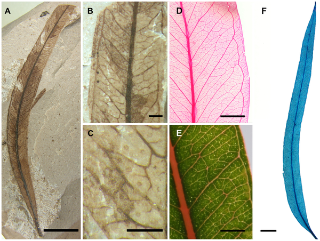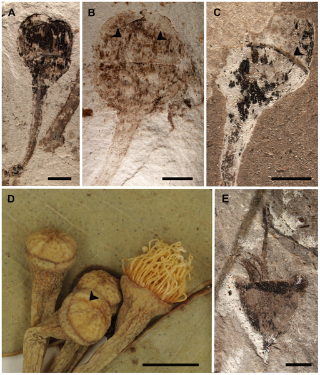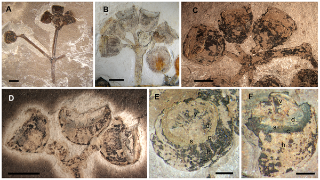The evolutionary history of Eucalyptus and the eucalypts, the larger clade of seven genera including Eucalyptus that today have a natural distribution almost exclusively in Australasia, is poorly documented from the fossil record. Little physical evidence exists bearing on the ancient geographical distributions or morphologies of plants within the clade. Herein, we introduce fossil material of Eucalyptus from the early Eocene (ca. 51.9 Ma) Laguna del Hunco paleoflora of Chubut Province, Argentina; specimens include multiple leaves, infructescences, and dispersed capsules, several flower buds, and a single flower. Morphological similarities that relate the fossils to extant eucalypts include leaf shape, venation, and epidermal oil glands; infructescence structure; valvate capsulate fruits; and operculate flower buds. The presence of a staminophore scar on the fruits links them to Eucalyptus, and the presence of a transverse scar on the flower buds indicates a relationship to Eucalyptus subgenus Symphyomyrtus. Phylogenetic analyses of morphological data alone and combined with aligned sequence data from a prior study including 16 extant eucalypts, one outgroup, and a terminal representing the fossils indicate that the fossils are nested within Eucalyptus. These are the only illustrated Eucalyptus fossils that are definitively Eocene in age, and the only conclusively identified extant or fossil eucalypts naturally occurring outside of Australasia and adjacent Mindanao. Thus, these fossils indicate that the evolution of the eucalypt group is not constrained to a single region. Moreover, they strengthen the taxonomic connections between the Laguna del Hunco paleoflora and extant subtropical and tropical Australasia, one of the three major ecologic-geographic elements of the Laguna del Hunco paleoflora. The age and affinities of the fossils also indicate that Eucalyptus subgenus Symphyomyrtus is older than previously supposed. Paleoecological data indicate that the Patagonian Eucalyptus dominated volcanically disturbed areas adjacent to standing rainforest surrounding an Eocene caldera lake.

A–B. MPEF-Pb 2329, A. Overall view showing the linear to lanceolate shape, the acute and acuminate apex, and the acute and decurrent base. B. Detail of the venation pattern; note the intramarginal, secondary, and intersecondary veins. C. MPEF-Pb 3729, detail of lamina showing island oil glands and higher order venation pattern. D. E. bridgesiana R.T. Baker, BH 37791, detail of the higher order venation pattern. E. E. camaldulensis Dehnh, detail of the lamina showing the island oil glands. F. E. tereticornis Sm., PBP-1003, overall view of a cleared leaf; note the general morphology of the lamina and the venation pattern. Scale bars: A, F, 1 cm; B–C, 1 mm; D–E, 5 mm.
doi:10.1371/journal.pone.0021084.g002

A. MPEF-Pb 3735, overall view of flower bud showing corolline operculum and transverse scar left after loss of the calyx. B. MPEF-Pb 3733, flower bud with hemispherical hypanthium and corolline operculum of coherent petals (arrows show petal margins). C. MPEF-Pb 3734, calycine scar (arrow) denotes the separation between the hypanthium and corolline operculum. D. E. microcorys, BH 37596, flower buds and open flower; note the hypanthium, and corolline operculum of coherent petals with visible margins (arrow) on the flower buds. E. MPEF-Pb 3738, bisexual flower with single style and stigma and numerous stamens. Scale bars: A–C, E, 2 mm; D, 3 mm.
doi:10.1371/journal.pone.0021084.g003

A. MPEF-Pb 3750, infructescence composed of two umbellasters. B. MPEF-Pb 981, capsules in unbellaster. C. MPEF-Pb 3740, infructescence showing the morphology and orientation of the fruit disks. D. MPEF-Pb 3739, infructescence composed of at least three fruits showing valves and disks. E–F. MPEF-Pb 2374. E. Top view of a capsule showing corolline operculum scar (c), staminophore scar (s), valves (v), disk (d), and hypanthium (h). F. Side view of capsule showing the same features. Scale bars: A, B, D, 3 mm; C, 2 mm; E–F, 1 mm.
doi:10.1371/journal.pone.0021084.g004
Citation: Gandolfo MA, Hermsen EJ, Zamaloa MC, Nixon KC, González CC, et al. (2011) Oldest Known Eucalyptus Macrofossils Are from South America. PLoS ONE 6(6): e21084. doi:10.1371/journal.pone.0021084
Editor: Andrew Allen Farke, Raymond M. Alf Museum of Paleontology, United States of America



 June 5th, 2013
June 5th, 2013  Riffin
Riffin  Posted in
Posted in  Tags:
Tags: 